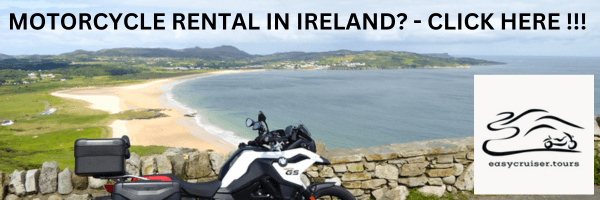Last updated on May 14, 2024
Ireland is an experience – no matter what means of transport you use. The west coast is breathtakingly beautiful, with high cliffs, wild surf and white sandy beaches.
Page Contents (click line to jump the text)
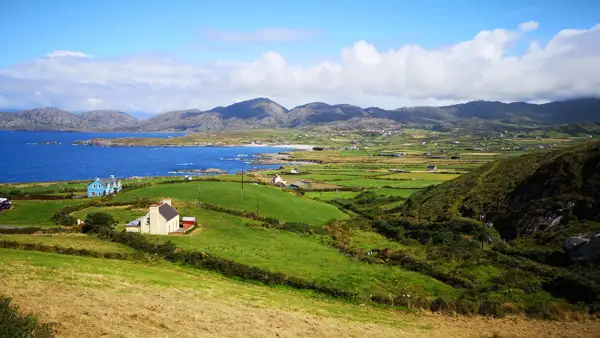
Intro
Emerald green, the island rises from the azure Atlantic – and is therefore also called Emerald Isle. The south-east coast and the small low mountain ranges are also truly beautiful.
Add to that the cosy, friendly serenity of the Irish, many castles and palaces, colourful little towns and quaint pubs, of course. You can slow down in Ireland!
By bike, you naturally get a much closer relationship with nature and the people around you than by car. And so a cycling trip along the Wild Atlantic Way is definitely a particularly impressive experience.
General information about cycling in Ireland
So much greenery needs water – and it can rain in Ireland. Not always, but every now and then, even in summer. Usually it is a drizzle or a small shower and then it clears up again.
We have lived in Ireland for several years. We have our second home there and run our motorbike rental business here in the summer (www.easycruiser.tours). We also have nice guest rooms. As insiders, we know the weather well.
I would sum it up like this: If you come from northern Germany, Ireland won’t scare you either, the conditions are roughly comparable. So pack your rain gear and that’s about it. Oh yes: Since Ireland is an island, it tends to get windy. Especially on the coasts.
The good news is that daytime temperatures in the summer months are usually between 15-25 degrees, and a few degrees lower in spring and autumn. It rarely gets really hot or really cold, as the Gulf Stream along the Atlantic coast has a very compensating effect. This means you usually have a pleasant temperature window without any great extremes – perfect for cycling, isn’t it?
Cycle paths are rather rare in Ireland. Most of the time you share the road with other road users. The excellent cycling routes are on the main roads and the smallest back roads. Since Ireland is much less populated than Germany (for example), there is usually very little traffic on the small country roads.
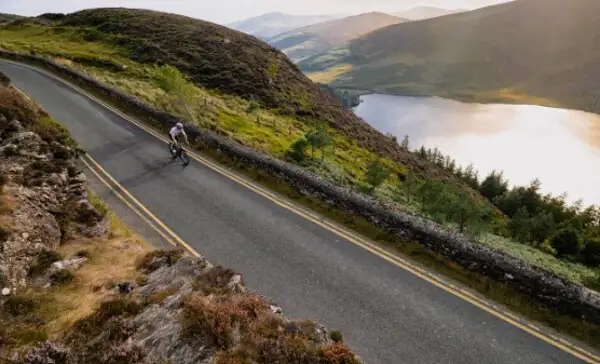
And the Irish are used to “obstacles”: walkers, bicycles, horse riders, cows or sheep are on the road here, along with a few tractors. The Irish put on yellow waistcoats and use the roads – all of them. Cars have to swerve or brake, that’s normal here.
If you are driving on your own, look for “L” (local roads) and “R” (regional roads) on the map, these are the smaller ones. Avoid “N” roads (national roads), which are the big and faster national roads.
The small country roads are often the most beautiful: you pass farms over gentle hills, children play along the road, the border collie accompanies you for a while and the trekker driver waves at you. Oops, brake quickly, sheep on the road again!
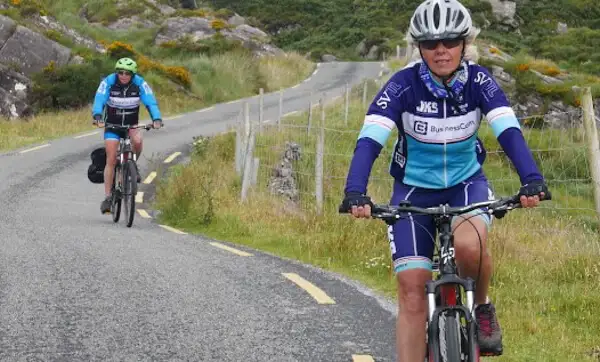
However, these small roads are often extremely narrow and the asphalt (Tarmac) rough, wavy and potholed. you have to live with that. The suspension and padded gloves and cycling shorts absorb the roughest “hops” and the wide tyres swallow the rest. I have already indicated that a coarser trekking bike runs better here than a fine racer with narrow tyres.
You won’t be able to go too fast here – but that doesn’t matter. Don’t take on too much distance and ride calmly and evenly, then wind and bumpy roads don’t have to lead to stress.
Ireland’s Atlantic Coast
Where is the most beautiful place in Ireland? There are many beautiful places to discover. But the highlight of Ireland is surely the wild Atlantic coast. The Wild Atlantice Way, signposted as a car route, stretches over 2500km from the northern tip of Ireland to the south coast. However, it partly follows roads that are not ideal for cyclists. Eurovelo 1 also follows the route in principle – but on roads that are as cycle-friendly as possible.
Greenways in Ireland
The trend towards cycling has arrived in Ireland and efforts are being made to improve the infrastructure for cycle tourists. There are already some “greenways”, i.e. cycle routes that run off normal roads, and more are being planned and developed. A nice example is the 40km long “Waterford Greenway”, which runs along a disused railway line, or the 100km long “Royal Canal Greenway”, which was built along old towpaths along an inland canal. The long-distance Eurovelo 1 and 2 routes include the existing greenways, so you don’t need to research them.
The Eurovelo 1
Eurovelo strives to create long-distance walking routes throughout Europe. Eurovelo 1 is the Atlantic Coast Route. It stretches from Portugal to Spain, France, England, Ireland, Northern Ireland, Scotland and the North Cape of Norway. In Ireland, it starts at the ferry port of Rosslare in the south-east of the island, follows the south coast, then the west coast and into the north-west of Ireland, where it then turns into Northern Ireland and ends in Belfast. It covers 2300km in Ireland and 230km in Northern Ireland.
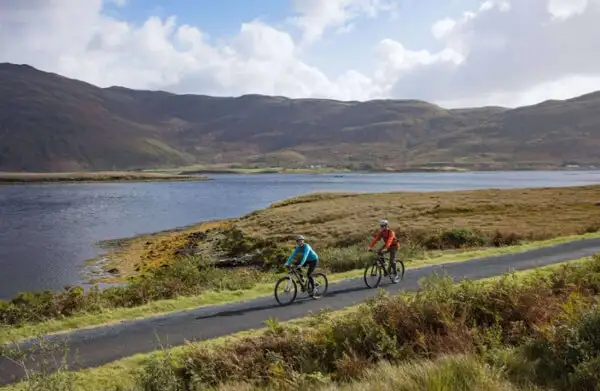
The Eurovelo 2
This section is part of the Capital City Route. From Dublin to Athlone it is developed as a cycle route, the rest of the way to Galway is still under development. From Dublin to Galway you can expect to cycle approximately 230km.
Guide, maps and GPS tracks
The exact route of Eurovelo 1 and 2 can be found on the websites: en.eurovelo.com/ev1/ireland and en.eurovelo.com/ev2/ireland. Maps, guides and GPS tracks can be found on the Eurovelo website or directly at: https://www.esterbauer.com/.
Arrival and departure
If you look at the start point in Rosslare and the end point in Belfast, it makes sense if you are cycling the whole Atlantic Coast Route.
However, most people will not have that much time and will only be able to cycle for a week or two in Ireland. In that case you can fly to Dublin, take a train or bus to e.g. Cork, Limerick, Galway or Westport and start the tour there.
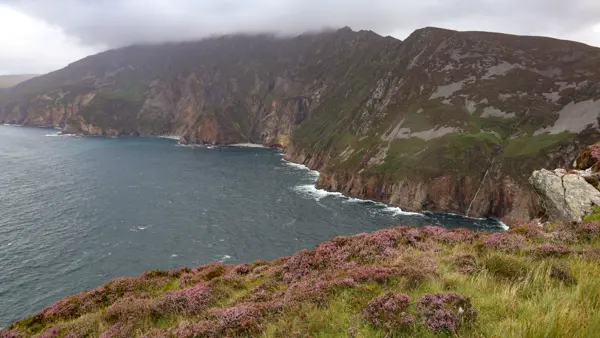
Connections from Dublin to every corner of Ireland are usually good, but connections between all other places and towns are often not, especially if they are small towns. So find a well-connected start town on the coast and a well-connected end town, then take a bus/train from Dublin to the coast, cycle a distance and take a bus/train back to Dublin.
If you are travelling by car and bike, you can take the ferry to Dublin or Rosslare. If you don’t want to do a round trip and leave the car behind, Dublin is also a good starting point to return to in case of doubt.
You can find train connections at: www.irishrail.com. A large long-distance bus company is: www.buseireann.ie.
Conclusion
Ireland is worth a cycling trip – definitely! The landscape is a dream, the coasts are spectacular and the Irish are hospitable. Whether you start in the south or the north, you will have a lot of fun on your cycling trip in Ireland and that’s what I wish you – lots of fun!
More interesting articles for you
WHERE CAN I RENT A BICYCLE FOR THE BIG TOUR IN IRELAND?
CLOTHING AND PERSONAL EQUIPMENT FOR CYCLE TOURING IN IRELAND
CAN I TAKE MY OWN BICYCLE TO IRELAND? PRACTICAL TIPS
MOUNTAIN BIKING AND DOWNHILL IN NORTHERN IRELAND – 4 GREAT TIPS
Photo credits cover photo: Wild Atlantic Way road sign, photo by Ulrich Knüppel-Gertberg (www.easycruiser.tours, www.irland-insider.de, www.ireland-insider.com)
